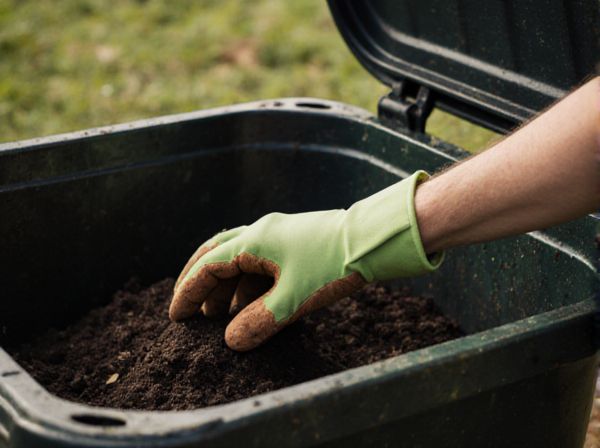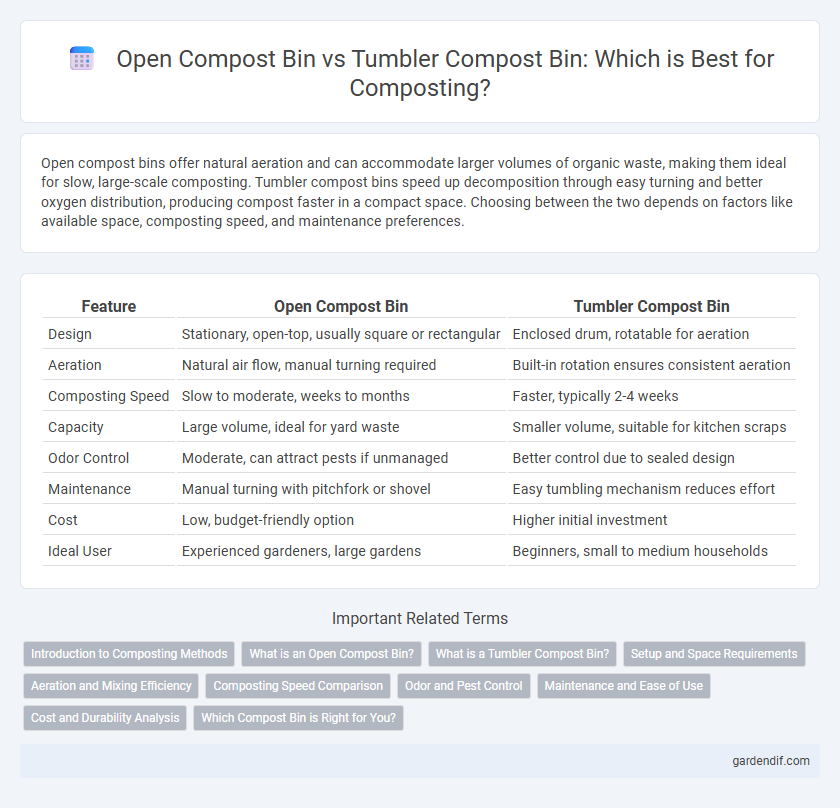
Open compost bin vs Tumbler compost bin Illustration
Open compost bins offer natural aeration and can accommodate larger volumes of organic waste, making them ideal for slow, large-scale composting. Tumbler compost bins speed up decomposition through easy turning and better oxygen distribution, producing compost faster in a compact space. Choosing between the two depends on factors like available space, composting speed, and maintenance preferences.
Table of Comparison
| Feature | Open Compost Bin | Tumbler Compost Bin |
|---|---|---|
| Design | Stationary, open-top, usually square or rectangular | Enclosed drum, rotatable for aeration |
| Aeration | Natural air flow, manual turning required | Built-in rotation ensures consistent aeration |
| Composting Speed | Slow to moderate, weeks to months | Faster, typically 2-4 weeks |
| Capacity | Large volume, ideal for yard waste | Smaller volume, suitable for kitchen scraps |
| Odor Control | Moderate, can attract pests if unmanaged | Better control due to sealed design |
| Maintenance | Manual turning with pitchfork or shovel | Easy tumbling mechanism reduces effort |
| Cost | Low, budget-friendly option | Higher initial investment |
| Ideal User | Experienced gardeners, large gardens | Beginners, small to medium households |
Introduction to Composting Methods
Open compost bins provide a traditional, cost-effective method for breaking down organic waste through natural aerobic processes, offering high capacity ideal for large gardens. Tumbler compost bins enhance decomposition speed and convenience by allowing regular, easy turning of materials, minimizing odor and pest issues in smaller spaces. Choosing between these composting methods depends on factors such as available space, desired processing time, and maintenance preferences.
What is an Open Compost Bin?
An open compost bin is a simple, stationary container that allows organic waste like kitchen scraps and garden clippings to decompose through natural aeration and microbial activity. These bins typically have a mesh or slatted design that promotes airflow, essential for accelerating the breakdown process and preventing odors. Open compost bins are cost-effective, easy to use, and suitable for gardeners aiming to recycle organic material into nutrient-rich compost without frequent turning.
What is a Tumbler Compost Bin?
A tumbler compost bin is a sealed container designed to facilitate faster decomposition by allowing easy aeration through spinning or tumbling. It retains heat and moisture efficiently, accelerating the breakdown of organic waste compared to open compost bins. This bin type reduces pests and odors, making it ideal for smaller spaces or urban environments.
Setup and Space Requirements
Open compost bins require minimal setup, typically just a designated outdoor area with good ventilation and easy access for turning the pile manually, making them suitable for larger spaces. Tumbler compost bins involve a more complex setup with a sealed container mounted on a frame for easy rotation, ideal for smaller spaces or patios where efficient space use and odor control are priorities. While open bins need ample ground space and less initial investment, tumblers offer compact, elevated designs that reduce the footprint and simplify aeration but may require more upfront cost and assembly.
Aeration and Mixing Efficiency
Open compost bins provide natural aeration through regular manual turning, which promotes microbial activity but can be labor-intensive and less consistent. Tumbler compost bins feature enclosed, rotating chambers that ensure uniform mixing and enhanced oxygen flow, accelerating decomposition while reducing effort. The controlled aeration and mixing efficiency of tumblers optimize composting speed and quality compared to open bins.
Composting Speed Comparison
Open compost bins generally allow for slower decomposition due to limited aeration and moisture control, resulting in composting times of several months. Tumbler compost bins enhance airflow and enable frequent mixing, significantly accelerating the composting process to as little as 4 to 6 weeks. Factors such as temperature regulation and input material size also influence the speed difference between the two systems.
Odor and Pest Control
Open compost bins often struggle with odor control due to limited aeration and easy access for pests such as rodents and flies, making waste management challenging in urban settings. Tumbler compost bins enhance aeration through regular rotation, significantly reducing odors by promoting aerobic decomposition and deterring pests by creating a sealed environment. Effective pest control and odor mitigation are critical factors favoring tumbler compost bins for sustainable, hygienic composting.
Maintenance and Ease of Use
Open compost bins require regular turning with a pitchfork or shovel to maintain aeration, which can be labor-intensive but allows easy access for adding a variety of organic materials. Tumbler compost bins feature a sealed design and rotating mechanism, significantly reducing manual aeration efforts and accelerating decomposition while minimizing pests and odors. Maintenance for tumblers is generally simpler and cleaner, though they may have limited capacity compared to open bins, which are more flexible for large volumes but demand consistent physical effort.
Cost and Durability Analysis
Open compost bins typically cost less upfront, ranging from $30 to $100, and offer straightforward durability with minimal moving parts, making them resistant to wear over time. Tumbler compost bins, priced generally between $70 and $250, feature rotating mechanisms that may require occasional maintenance but enable faster decomposition by improving aeration. When considering long-term value, open bins excel in low-cost durability while tumblers provide enhanced composting efficiency at a higher investment and potential repair needs.
Which Compost Bin is Right for You?
Open compost bins offer simplicity and affordability, allowing natural aeration and larger capacity ideal for garden waste and yard trimmings. Tumbler compost bins accelerate decomposition with easy rotation, producing nutrient-rich compost faster, suitable for kitchens or limited spaces. Choose based on your volume of organic waste, space availability, and desired composting speed for optimal garden enrichment.
Open compost bin vs Tumbler compost bin Infographic

 gardendif.com
gardendif.com